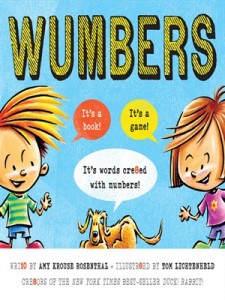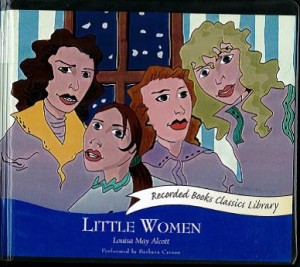Wumbers
 “What do you get when you combine a word with a number? A wumber!” Wumbers is wri10 by Amy Krouse Rosenthal and illustr8ed by Tom Lichtenheld, the dynamic duo who made Duck! Rabbit! and other books I love passion8ly. With Wumbers, kids have 2 pay at10tion to the sound of the number word to figure out how to read the wumber. 1ce your students get the gist of it, they’ll want 2 make up wumbers of their own!
“What do you get when you combine a word with a number? A wumber!” Wumbers is wri10 by Amy Krouse Rosenthal and illustr8ed by Tom Lichtenheld, the dynamic duo who made Duck! Rabbit! and other books I love passion8ly. With Wumbers, kids have 2 pay at10tion to the sound of the number word to figure out how to read the wumber. 1ce your students get the gist of it, they’ll want 2 make up wumbers of their own!
Because Wumbers focuses kids’ attention on the small sounds in words, it’s an ideal book to hit the CCSS of Phonological Awareness. Distinguishing the numbers from the letters in the words is part of Print Concepts. 1 book for 2 standards = gr8ful teacher and 4tunate students!
As you read Wumbers to your students, call at10tion first to the way the wumber looks. What number is mixed with letters to make a new word? 1ce students identify the number, say it out loud a few times, then blend the number name with the other letters slowly. Let kids have the thrill of calling out the wumber. It7ly! (Get it – it’s heavenly? Ok, I’m still working on a good one for 7.)
Before you let your students loose on reading and writing wumbers on their own, practice as a group. Choose a number, an easy one like 2 or 4 (because obviously 7 will pose challenges, even for those of us with plenty of wumber po10tial.) Write the number word and any phonological variations: 2 is two, to, too, tu, etc. Now, see if you can come up with words that have that to-tu sound in them. Tuba becomes 2ba. Toothbrush becomes a 2thbrush. Because she is genius, Amy Krouse Rosenthal has a free activities kit available through her website: whoisamy.com. If you and your students come up with some 1derful wumbers, email me! 2gether we will celebr8 Wumbers!
For more about the illustrator, please visit tomlichtenheld.com.
Read MoreGo Ahead and Judge
 As I’m weeding the youth collection in my public library, I am finding some gems. I know the old adage is “you can’t judge a book by its cover”, but really? If you had never heard of Little Women before and you saw this audiobook cover, what do you think the story would be about? Something disconcerting and yet intriguing, judging by the glassy-eyed stare of these girls! Little (Zombie) Women!
As I’m weeding the youth collection in my public library, I am finding some gems. I know the old adage is “you can’t judge a book by its cover”, but really? If you had never heard of Little Women before and you saw this audiobook cover, what do you think the story would be about? Something disconcerting and yet intriguing, judging by the glassy-eyed stare of these girls! Little (Zombie) Women!
So this week I’m recommending a simple activity that can be used with many books: redesigning the cover. If your library has some ugly book covers (I know mine has several), ask kids to read the book and make a new cover that shows the main characters in a key plot moment. It’s a great way for kids to demonstrate reading comprehension (those Key Ideas & Details of the Common Core? Got it covered!) and it can be a nice alternative to or an option for a book report.
With new book covers designed by fellow students, those ugly books may have a renewed life, because even if we shouldn’t, we do judge books by their covers.
Read MoreKnock, Knock!
 Trent, one of my preschool pals, couldn’t stop giggling as he told me this gem, “So, a horse walks into a bar and the bartender says, ‘Hey, why the long face?'” Kids love good jokes – and they don’t seem to mind the bad jokes, either! Joke books are perfect for early and reluctant readers because:
Trent, one of my preschool pals, couldn’t stop giggling as he told me this gem, “So, a horse walks into a bar and the bartender says, ‘Hey, why the long face?'” Kids love good jokes – and they don’t seem to mind the bad jokes, either! Joke books are perfect for early and reluctant readers because:
1. Jokes are short.
2. You can flip through pages instead of reading sequentially so the thick books aren’t intimidating.
3. Humor makes them intrinsically motivating.
4. With “knock, knock” jokes, kids can already read some of the most important words (and you can use them for a great mini-lesson on those letter-sound combos of kn and wh.)
5. Joke books build Fluency and hit Range of Reading (two CCSS with one stone!)
My latest favorite joke book is Knock, Knock! illustrated by fourteen artists and published by Dial Books for Young Readers. Each artist chose a different “knock, knock” joke to illustrate. The repetition of words like “knock, knock” and “who’s there” plus the clues from the art make this book one most kids can read successfully, especially if you read it aloud first and let students guess what the punchlines to the jokes will be.
Rereading joke books in order to learn the jokes for future telling is probably the most fun way to build reading fluency. Make Knock, Knock! and other joke books available during choice reading time, then give your budding comedians a set time to tell jokes. This can be a one-time laugh-fest, or an ongoing event in your classroom. I liked to claim the end of the day as “Open Mike Time”. If students could gather their belongings and prepare for departure quickly, we’d have time for an “open mike” session where kids could come to the front of the room and tell a joke. This encouraged kids to get ready without dawdling, and for those who liked joking all day long, I could say, “Suzy, we won’t have time for Open Mike if we don’t use this time wisely.” Suddenly, being a class clown (at the appropriate time) is a good thing!
Read More
Words with Wings
This novel-in-verse is for the daydreamers and for the teachers who want to guide, not squash, those who have such vivid imaginations.
Words with Wings by Nikki Grimes is one of those gorgeously-written books you can read aloud to your class for wonderful group discussions and then watch them eagerly grab it to read independently. (Novels-in-verse are not only a great way to immerse your students in poetry, but it hits both Range of Reading and Fluency for Core Standards. Woohoo!) Imagine yourself reading aloud this page to your students and knowing that for some kids, it will hit home:
First Day
I duck down in the seat
of my new class.
To these kids,
I’m not Gabby yet.
I’m just Shy Girl
Who Lives
Inside Her Head.
No one even knocks
on the door
for a visit.
They don’t know
it’s beautiful
in here.
Gabby is a daydreamer, which sometimes causes problems in school and at home. But how can she help daydreaming, when words have wings? Some of the poems would make for great writing prompts in your classroom, like this one:
Waterfall
Say “waterfall”
and the dreary winter rain
outside my classroom window
turns to liquid thunder,
pounding into a clear pool
miles below,
and I can’t wait
to dive in.
To my absolute delight, Nikki Grimes named the teacher in this book Mr. Spicer after one of the coolest teachers I’ve ever meet, Ed Spicer. He teaches first grade here in Michigan and he is committed to giving his students time to daydream. Sometimes he plays music, sometimes it’s quiet. Sometimes he asks his students to write about their daydreams, or turn and talk about them, or daydream on a particular topic, like a science concept they are studying. I love the power of daydreaming and I adore Ed Spicer for encouraging his students to take a few moments to let their minds wander. Follow him on Facebook for more about his classroom because he is a wealth of amazing ideas.
So share Words with Wings with your students. For a quick Craft & Structure lesson, talk about the words Nikki Grimes chose that have “wings” for Gabby. Why did she choose these words? What words have wings for you? Give your students a few minutes just to daydream, wonder and imagine. It may become a favorite break in your classroom.
Happy September, everyone!
For more information about the author, please visit: nikkigrimes.com.
Read More







